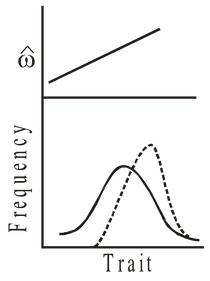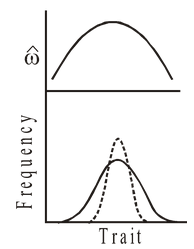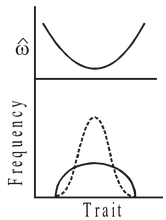Natural Selection
Theories of Evolution of Class 12
It is initiating force for evolution.
It is the most critical evolutionary process that leads to changes in allelic frequencies
It keeps check on the factors which are not in harmony with adaptative processes. Hence, preadapted individuals (variants in gene pool) survive longer and add more offsprings. Adaptive alleles are selected for transfering to next generation and so their frequencies increase Less adaptive alleles are not selected hence their frequency decrease.
In Darwinian terms the Survival and Fertility as bases of reproductive success are the Selection.
In modern terminology Selection is the consistent differences in contributing various genotypes to the next generation.
Depending upon the traits favoured natural selection can produce various results :
- Stabilising selection : If both small and large type individuals contribute lesser number of offsprings than the average size to the population it is stabilizing selection This reduces variation but does not change the mean value The rate of evolution is slow
- Directional selection : If individuals of one extreme size contribute more offspring than the other type then mean-sized population increase. If this selection operates for many generations an evolutionary trend with in the population emerges.
- Disruptive selection : When natural selection simultaneously favour the two extreme (opposite) traits it produces two peaks in the distribution of traits. It is of rare kind.
- Balancing selection : When a deleterious gene is retained to continue in a population through heterozygotes, this balances the loss occurring due to death of homozygotes. e.g. sickle cell gene in heterozygotic form. This is rare phenomenon and no explanation for the type of genetic variation in natural population.

Fig.3.5 Effect of natural selection on a variable trait (body size) — (a) Stabilising selection (left upper and lower set), (b) Directional selection (middle) and (c) Disruptive selection (Right)

Directional selection : linear selection for higher or lower phenotypic values, detected by an association between the mean of a trait and fitness. Directional selection increases (positive) or decreases (negative) the trait mean

Stabilizing selection : concave non-linear selection against extreme phenotypes, detected by a negative relationship between the second moment of a distribution and fitness. Stabilizing selection decreases the variance of a trait.

Disruptive selection : the opposite of stabilizing selection-convex nonlinear selection against intermediate phenotypes detected by a positive relationship between the second moment of a distribution and fitness.
Disruptive selection increases the variance of a trait.
Natural Selection and Polymorphism :
Some populations maintain variety of genotypes to occupy many environments. When two or more such forms are represented in high frequencies, the population is polymorphic e.g. human population represent A,B, AB and O blood groups; different skin color.
Existence of different genotypes through heterozygote superiority is another example which is meant for preserving genetic variability through heterozygote selection called as balanced polymorphism.
Heterozygotes (HbA, Hbs) for sickle cell develop anemia but they enjoy resistance to malaria, this is why the continuation of this deleterious gene has been favoured.
The loss of this deleterious gene due to death of the homozygotes is balanced by their presence in heterozygotes through their successful reproduction (balancing selection)









